
The Internet's Premier Classical Music Source
Related Links
- Mahler Reviews
- Latest Reviews
- More Reviews
-
By Composer
-
Collections
DVD & Blu-ray
Books
Concert Reviews
Articles/Interviews
Software
Audio
Search Amazon
Recommended Links
Site News
 Blu-ray Review
Blu-ray Review
Gustav Mahler
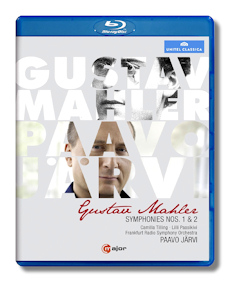
- Symphony #1 "Titan"
- Symphony #2 "Resurrection" *
* Camilla Tilling, soprano
* Lilli Paasikivi, mezzo-soprano
* Chorus of the Bavarian Radio
* NDR Chorus
Frankfurt Radio Symphony Orchestra/Paavo Järvi
Recorded live at Friedrich-von-Thiersch-Saal Kurhaus, Wiesbadan, Germany - August 23, 2012 (#1); Kloster Eberbach, Eltville am Rhein, Germany - June 26 & 27, 2010 (#2)
Bonus Track – Introduction to the Symphonies by Paavo Järvi
Unitel Classica/C Major Blu-ray 718104 149m + 20m (bonus) PCM Stereo DTS-HD Master Audio
Also available on DVD 718008:
Amazon
- UK
- Germany
- Canada
- France
- Japan
- ArkivMusic
- CD Universe
- JPC

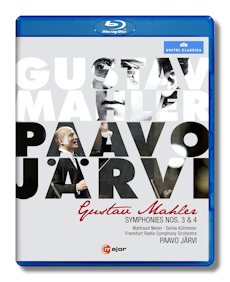
- Symphony #3 *
- Symphony #4 **
* Waltraud Meier, mezzo-soprano
** Genia Kühmeier, soprano
* Limburger Domsingknaben
* MDR-Rundfunkchor Leipzig
Frankfurt Radio Symphony Orchestra/Paavo Järvi
Recorded live at Kloster Eberbach, Eltville am Rhein, Germany - June 23 & 24, 2007 (#3); June 28 & 29, 2008 (#4)
Bonus Track - Paavo Järvi's Mahler
Unitel Classica/C Major Blu-ray 719204 165m + 18m (bonus) PCM Stereo DTS-HD Master Audio
Also available on DVD 719108:
Amazon
- UK
- Germany
- Canada
- France
- Japan
- ArkivMusic
- CD Universe
- JPC

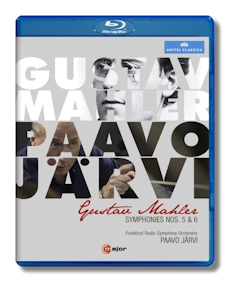
- Symphony #5
- Symphony #6
Frankfurt Radio Symphony Orchestra/Paavo Järvi
Recorded Live at the Kloster Eberbach, Eltville am Rhein, Germany - June 25 & 26, 2011 (#5); June 29 & 30, 2013 (#6)
Bonus Feature - Paavo's Mahler, Introduction to Symphonies 5 & 6
Unitel Classica/C Major Blu-ray 729404 2:38:49; 11:07 & 9:25 (Bonus tracks) PCM Stereo DTS-HD Master Audio
Also available on DVD 729308:
Amazon
- UK
- Germany
- Canada
- France
- Japan
- ArkivMusic
- CD Universe
- JPC

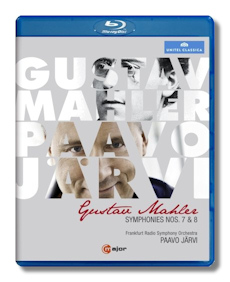
- Symphony #7 in E Minor
- Symphony #8 in E Flat Major "Symphony of a Thousand" *
- Erin Wall, soprano (Magna peccatrix)
- Ailish Tynan, soprano (Una poenitentium)
- Anna Lucia Richter, soprano (Mater gloriosa)
- Alice Coote, mezzo-soprano (Mulier samaritana)
- Charlotte Hellekant, mezzo-soprano (Maria aegyptiaca)
- Nikolai Schukoff, tenor (Doctor marianus)
- Michael Nagy, baritone (Pater ecstaticus)
- Ain Anger, bass (Pater profundus)
* Limburger Domsingknaben
* Europa Chor Akademie
* Czech Philharmonic Choir Brno
Frankfurt Radio Symphony Orchestra/Paavo Järvi
Recorded live at Friedrich-von-Thiersch-Saal Kurhaus, Wiesbadan, Germany - August 12, 2011 (#7); Alte Oper Frankfurt - May 24 & 25, 2013 (#8)
Bonus Feature - Paavo's Mahler, Introduction to Symphonies 7 & 8
Unitel Classica/C Major Blu-ray 729604 2:43:37; 7:12 & 11:15 (Bonus tracks) PCM Stereo DTS-HD Master Audio
Also available on DVD 729508: Amazon - UK - Germany - Canada - France - Japan - ArkivMusic - CD Universe - JPC

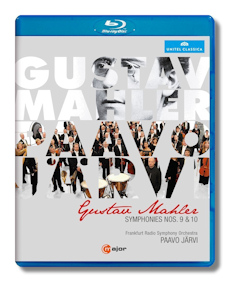
- Symphony #9 in D Major
- Symphony #10 in F Sharp minor: I. Adagio
Frankfurt Radio Symphony Orchestra/Paavo Järvi
Recorded live at Kloster Eberbach, Eltville am Rhein, Germany - June 27 & 28, 2009 (#9); June, 2008 (#10)
Bonus Track - Paavo Järvi's Mahler
Unitel Classica/C Major Blu-ray 729804 117:00+18:00 PCM Stereo DTS-HD Master Audio
Also available on DVD 729308:
Amazon
- UK
- Germany
- Canada
- France
- Japan
- ArkivMusic
- CD Universe
- JPC
With these five discs C Major and Unitel Classica have given us the first complete Mahler cycle on Blu-ray/DVD with Paavo Järvi conducting the Frankfurt Radio Symphony Orchestra. All of the symphonies were recorded live at the Rheingau Festival between 2007 and 2013. The majority of the performances took place in the magnificent church at Kloster Eberbach, a former Cistercian monastery, with the First, Seventh, and Eighth recorded in the art nouveau surroundings of the concert hall in the Kurhaus Wiesbaden.
The Frankfurt Radio Symphony (more properly known as the HR-sinfonieorchester) has a long tradition of Mahler playing, going back to its first principal conductor Hans Rosbaud. In 1988, under the direction of then principal conductor Eliahu Inbal, the orchestra played the first complete digital Mahler cycle. There is no question in my mind, after listening to this cycle, that it is in the front rank of Mahler orchestras.
The orchestra has a rich string sound, complemented by wind and brass sections that play with great assurance and are temperamentally attuned to Mahler's multiple moods and styles. Mahler makes heavy demands upon solo musicians and the principals respond extremely well. The only soloist credited by name is Samuel Seidenberg, whose horn solo is outstanding in the scherzo of the Fifth. But the standard is very high throughout the whole cycle. Highlights include the deliberately clumsy frère Jacques played by the double bass in the third movement of the First; the solos from the trombone and posthorn in the first and third movements of the Third; the horn solo in the second Nachtmusik from the Seventh (Seidenberg again); and the solo viola in the second and third movements of the Ninth.
Mahler was a great orchestrator and one of the real strengths of Paavo Järvi's conducting is his skill in bringing out the complex texture of Mahler's orchestral sound and striking a balance between the different voices. The slow movements display this skill to best effect. The first and last movements of the Ninth and the Adagio of the Tenth are particularly memorable. But the luscious adagios are, in a sense, the low-hanging fruit. The real test of a Mahler conductor is how they let the orchestra speak in the movements that are less "musicianly" – the movements where Mahler's taste for country dances, for the grotesque, and for the ironic comes to the fore. In this context Järvi does particularly well in the scherzo centerpiece of the Fifth.
In the best performances in the cycle Järvi combines his ability to bring out the Mahler's complicated orchestral textures with a sure sense of the overall architecture and what one could call the dramatic direction of the symphony. Drama and architecture seem to work best for Järvi in the middle and later period instrumental symphonies – the Fifth, Sixth, Seventh, and Ninth. These are, not coincidentally, the symphonies where we see the least of the Mahler "trademarks". My impression from listening to the cycle is that Järvi is least comfortable in those movements where the music constantly seems to be going through drastic personality shifts and mood swings. He lacks the conviction with which a conductor like Leonard Bernstein, for example, would throw himself into Mahler's exaggerated waltzes or grotesque funeral marches.
Nor is Järvi always comfortable with the vocal symphonies. The Third is an unqualified success, particularly in the first and last movements where Järvi communicates a compelling vision of the overall structure of these two massive pieces of music. The Eighth, however, is probably the least successful performance in the cycle. This is definitely a piece where the conductor needs to go in full bore in order to harness Mahler's massive forces, but Järvi comes across as lacking conviction. This is a shame because the choirs are first-rate and so too are the soloists, particularly Anna Lucia Richter's Mater Gloriosa. In fact, the quality of singing is very high throughout the cycle. The only vocal soloist who seems out of place is Waltraute Meier in the Fourth. Meier's intonation is more reminiscent of the Ring Cycle's Erda than the movement can sustain.
It is a shame that the liner notes are rather sketchy, with perfunctory comments on the symphonies and no information at all about the conductor, the orchestra, or the soloists. This is par for the course from Unitel Classica/C Major. They really need to get their act together. However, the sound and video quality are extremely good. The sound comes with in two-channel PCM or multichannel DTS-HD 5.1. I listened in two-channel and was pleasantly surprised by the acoustics at Kloster Eberbach. Only in the Eighth was I curious about how surround sound would work. Michael Ciniselli is the video director throughout.
My principal quibble with the videography is that there are too many instrumental close-ups and not enough use made of the fine surroundings in Kloster Eberbach and the Kurhaus Wiesbaden. (The Adagio of the Tenth is an honorable exception.) This is not just a visual point. The videography can affect how one listens to the movement. It is very difficult not to attend predominantly to the music line being filmed. This can be a barrier to appreciating Mahler's contrapuntal complexity – definitely a shame, given how good Järvi is at bringing that complexity out.
In conclusion, no Mahler cycles are uniformly excellent, and there is no doubt but that this is a fine cycle. If you are in the market for a complete cycle on DVD or Blu-ray then this is the only game in town. But even leaving that aside five of the performances are very good (the Third, the three middle instrumental symphonies, and the Ninth), with the Third and the Ninth warmly recommended.
Copyright © 2015, José Luis Bermúdez





















